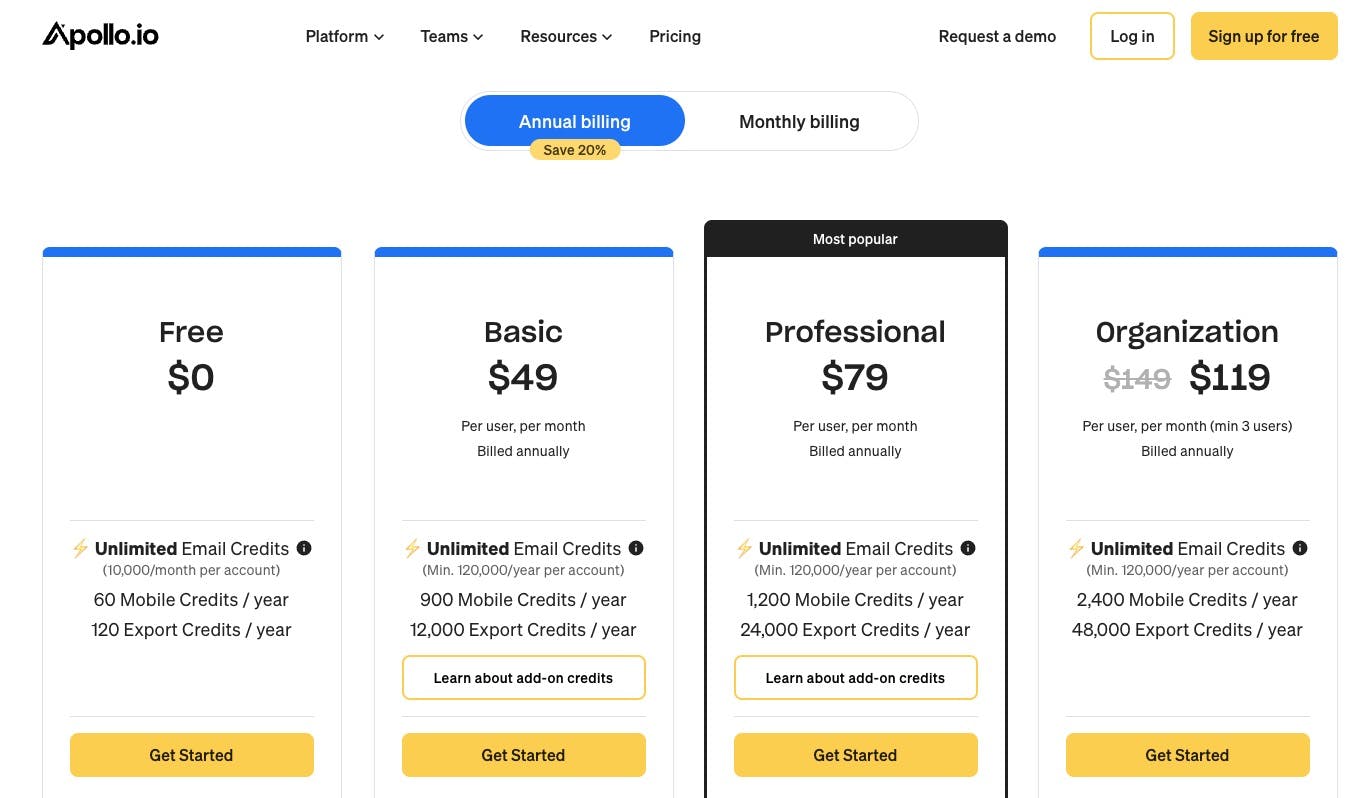Revenue
$150.00M
2025
Valuation
$1.60B
2025
Growth Rate (y/y)
40%
2025
Funding
$251.30M
2025
Revenue
Sacra estimates that Apollo.io hit $150M in annual recurring revenue (ARR) at the end of May 2025. Apollo ended 2024 at $134M ARR, up 40% from $96M in 2023.
Apollo experienced steady growth in ARR over the past six years. Beginning with an ARR of $2.5M in 2018, the company's revenue increased to $5M in 2019, showing a 100% growth. In 2020, Apollo's ARR rose to $8M, a 60% increase from the previous year.
The following year, 2021, saw a further increase in ARR to $24M, which is a 200% rise compared to 2020. Apollo's ARR doubled to $48M in 2022.
Valuation
Apollo.io is valued at $1.60B following their August 2023 financing round led by Bain Capital Ventures. Based on 2023 revenue of $96M and a $1.60B valuation, Apollo.io trades at a 16.67x revenue multiple. The company has raised $251.30M in total funding to date. Key investors include Bain Capital Ventures, Sequoia Capital, and Tribe Capital, with participation from Nexus Venture Partners.
Business Model

Apollo found product-market fit giving SMB and startup sales teams access to a vertically integrated set of lead prospecting and outreach tools.
As of the late 2000’s, sales teams would use data brokers like Dun & Bradstreet or ZoomInfo to get lead lists and then import them into a CRM like Salesforce. Around 2010, ZoomInfo started differentiating from the pure data brokers by layering on tools for email validation, list segmentation, and database cleaning.
By 2015, ZoomInfo had strong positioning in the mid-market. Their customers typically had an existing sales stack but needed a data provider to get fresh leads into Salesforce. They solved the data product retention problem—where customers would sign up for a specific dataset and then cancel—by having their customers pre-pay for a year.
Apollo made the early key observation that 1) startups and SMBs increasingly wanted access to the same kind of data that ZoomInfo offered but didn’t want to pre-pay $9K on an annual contract, and 2) those startups and SMBs often didn’t have the same level of sophistication in their stack, and could therefore benefit from an all-in-one data and workflow tool.
Going bottom-up and self-serve contra ZoomInfo’s top-down, enterprise approach, Apollo added $50/month and $100/month SMB-focused plans—to target the large market of SMBs that wanted ZoomInfo-like data without a $9K annual contract.
Apollo prices prospecting similarly to how ZoomInfo does, with both per-seat pricing and usage-based pricing around the number of records exported, but packages them with email and calling which customers get “for free”.
Product

Apollo launched as a web scraping product with workflow tools layered on that helped sales teams quickly generate lists of leads and start emailing them immediately. Today, it is a go-to-market (GTM) platform that teams use to not just generate leads but prioritize outreach, create messages through generative AI, forecast revenue, and make calls.
Sales teams typically begin using Apollo by building an ideal customer profile (ICP) based on industry, company size, headcount, ARR, HQ location, and other data points. By applying those to a filter in Apollo, they can instantly generate a list of companies.
They can then drill down into that list of companies with various persona traits—title, seniority, department, and more—to create a list of individuals who they want to target. After saving those individuals to a list, they can either export it in CSV form to import into a CRM or email tool, or they can begin sending emails and making phone calls to them directly from within Apollo.
Key Apollo features include a Chrome extension for easy access to contact details while browsing sites like LinkedIn, over 65 search filters, job change alerts, buying intent data, email sequences, a click-to-call dialer, and a task manager.
Additionally, it provides data enrichment, a rules engine, API integration, strong data security measures, and integrations with major CRM and marketing tools. Apollo.io has a database of over 250 million contacts and 60 million companies.
Competition
Salesforce's rich, flexible user model began to be commonplace in the early 2010's as every sales and marketing product—from HubSpot to Klaviyo—started to enable teams to enrich the customer data in their CRM with custom attributes.
Teams could buy data from brokers like ZoomInfo, pull it programmatically via a tool like Apollo, or get it via API with Clearbit, and then push that data into their sales and marketing stack in order to make their outreach more targeted.
What we're seeing today is that those two sides—data and workflow—are increasingly coming together as tools like Apollo look to vertically integrate them into the same product.
ZoomInfo
ZoomInfo, which was founded in 2007, began layering on software tools for cleaning and exporting data into your CRM around 2010. In 2020, shortly before going public in June, they executed on a big re-positioning as a “batteries included” go-to-market (GTM) platform that layers tools for email, live chat, and advertising on top of their database of 70M phone numbers and 174M email addresses.
As of ZoomInfo's last quarter, they have 1,869 customers with a greater than $100K annual contract value (ACV), 104% net revenue retention, and 40% profit margins. They've launched workflow products around sales ($40B TAM), operations ($30B TAM), marketing ($20B TAM), and recruiting ($10B TAM).
LinkedIn launched Sales Navigator in 2014 to help salespeople use their social networks and LinkedIn’s data on 950M+ people in 200 countries to build better lists, message prospects, and sync their leads into Salesforce—it grew to $1B in revenue as of 2021.
HubSpot
HubSpot launched as a sales and marketing suite for startups and SMBs in 2006. The company's early positioning was heavy on the emerging concept of inbound marketing—creating content and attracting users through social and organic search.
Today, HubSpot is an all-in-one suite for SMBs to manage their CRM, do customer service, run operations, reach out to and close leads, and more.
In 2023, HubSpot acquired the data enrichment platform Clearbit—and its data on 20 million companies and 500 million people. By acquiring Clearbit, HubSpot can natively integrate all of LinkedIn’s public data into its CRM for a "batteries included" user experience similar to ZoomInfo.
Unlike with Salesforce’s acquisition of the now-shuttered Jigsaw in 2010, Clearbit’s downside risk is mitigated by its purely programmatic scraping of exclusively public data sources—the long-term upside lies in owning both data and the customer record to drive a step function increase in AI personalization in sales & marketing.
TAM Expansion
As the rise of LLMs like GPT-4 takes pure data sales and martech tools to zero and every sales product looks to integrate both data and workflow, we're seeing the competition to vertically integrate data and workflow heating up.
As a go-to-market platform that brings sales, biz dev, marketing and exec teams into one place, Apollo.io presents an insurgent threat to the all-in-one vision of tools like HubSpot.
Sacra expects the growing feature overlap between originally data-based tools like ZoomInfo and Apollo and workflow tools like HubSpot to drive consolidation as teams look to reduce redundant spend in 2024, reversing the trend of proliferation that we saw in sales tech from 2013 (~400 sales SaaS) to 2023 (1,000+ sales SaaS).
In Apollo’s upside case, AI is an accelerant helping them bring sales, biz dev, marketing and exec teams together via the flywheel by which the more data that Apollo gets, the better the insights and efficiency improvements they can provide. The more you use Apollo’s workflow tools, the better they can help prioritize your prospects by buying intent, generate more personalized emails, and provide more accurate revenue forecasting and analytics.
Funding Rounds
|
|
||||||||||||||||||
|
||||||||||||||||||
|
|
||||||||||||||||||
|
||||||||||||||||||
|
|
||||||||||||||||||
|
||||||||||||||||||
|
|
||||||||||||||||||
|
||||||||||||||||||
| View the source Certificate of Incorporation copy. |
News
DISCLAIMERS
This report is for information purposes only and is not to be used or considered as an offer or the solicitation of an offer to sell or to buy or subscribe for securities or other financial instruments. Nothing in this report constitutes investment, legal, accounting or tax advice or a representation that any investment or strategy is suitable or appropriate to your individual circumstances or otherwise constitutes a personal trade recommendation to you.
This research report has been prepared solely by Sacra and should not be considered a product of any person or entity that makes such report available, if any.
Information and opinions presented in the sections of the report were obtained or derived from sources Sacra believes are reliable, but Sacra makes no representation as to their accuracy or completeness. Past performance should not be taken as an indication or guarantee of future performance, and no representation or warranty, express or implied, is made regarding future performance. Information, opinions and estimates contained in this report reflect a determination at its original date of publication by Sacra and are subject to change without notice.
Sacra accepts no liability for loss arising from the use of the material presented in this report, except that this exclusion of liability does not apply to the extent that liability arises under specific statutes or regulations applicable to Sacra. Sacra may have issued, and may in the future issue, other reports that are inconsistent with, and reach different conclusions from, the information presented in this report. Those reports reflect different assumptions, views and analytical methods of the analysts who prepared them and Sacra is under no obligation to ensure that such other reports are brought to the attention of any recipient of this report.
All rights reserved. All material presented in this report, unless specifically indicated otherwise is under copyright to Sacra. Sacra reserves any and all intellectual property rights in the report. All trademarks, service marks and logos used in this report are trademarks or service marks or registered trademarks or service marks of Sacra. Any modification, copying, displaying, distributing, transmitting, publishing, licensing, creating derivative works from, or selling any report is strictly prohibited. None of the material, nor its content, nor any copy of it, may be altered in any way, transmitted to, copied or distributed to any other party, without the prior express written permission of Sacra. Any unauthorized duplication, redistribution or disclosure of this report will result in prosecution.
